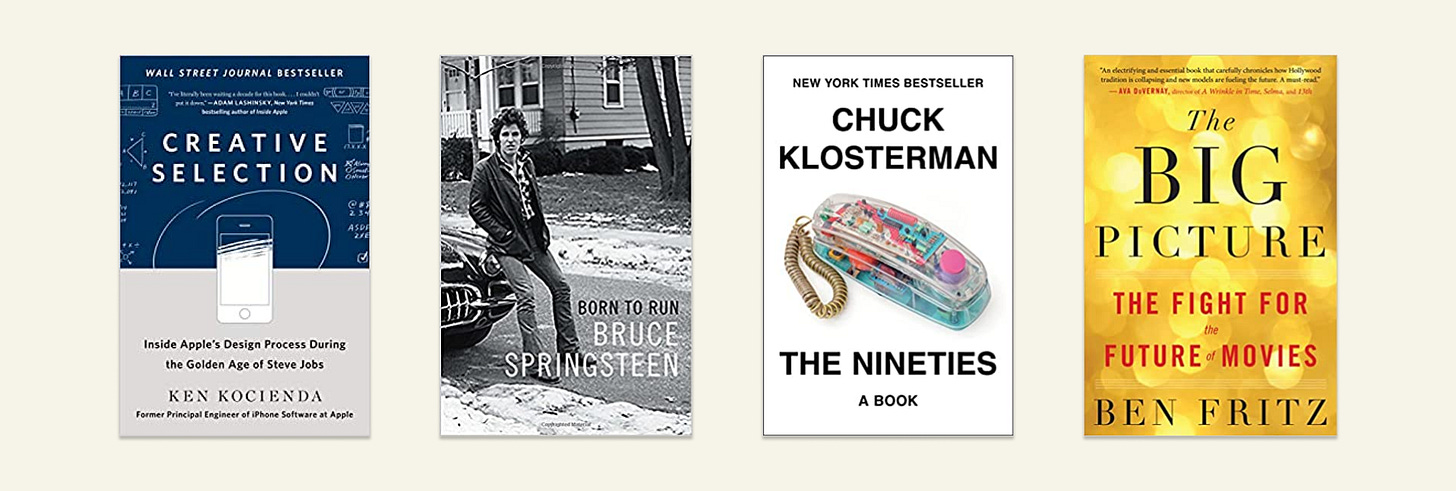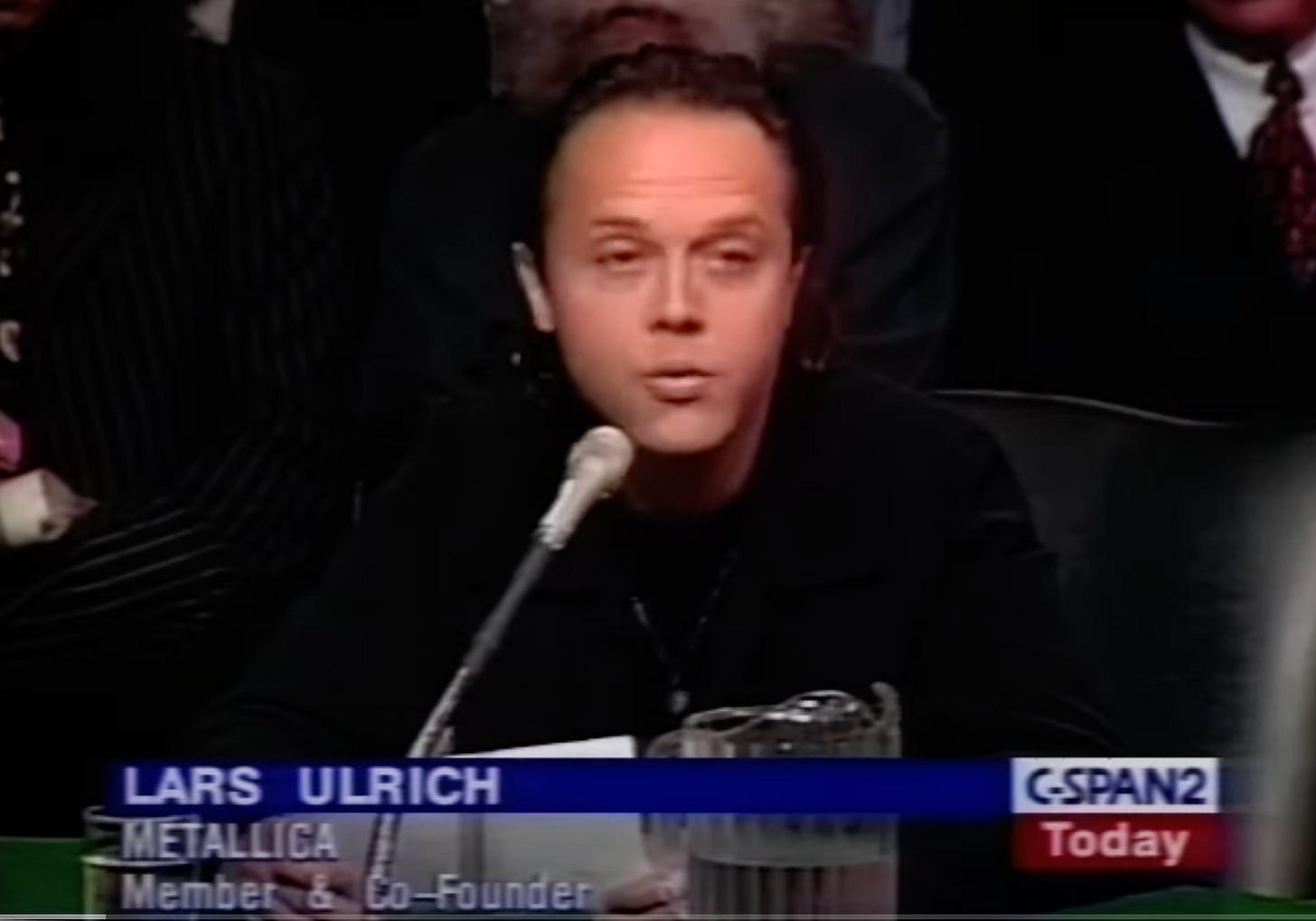2022: The Year in Books
Hi friends,
It’s been a while. I hope everyone is doing well! Originally, I planned on writing some “grandiose” essay summing up the year, but in the spirit of the holidays & my love for sharing books I’ve enjoyed reading, I’ve decided just to share my favorite reads from the year along with some additional context, facts, and thoughts.
Life is good and it’s even better with books.
If you’re interested in discussing any of the books below further or have any questions at all, feel free to shoot me an email or DM anytime. And remember, while all of my picks are subjective, taste matters.
Happy Holidays,
Web
Books of the Year
Nonfiction
Picasso’s War: How Modern Art Came to America (Eakin)
On the surface, Picasso’s War is about Pablo Picasso and the creation of the MoMA, but what it’s really about is artistic movements, the importance of creative output, the people behind-the-scenes, timing, passion, and Picasso. I’ve always been fascinated by movements in art, music, film, TV, etc… because I love thinking about the conditions that are needed for something/someone truly original & “game-changing” (both extremely rare) to break established norms & take hold in pop culture. It’s really difficult to create art with a completely original style—not just because of the creative calculus needed to make something unique & compelling, but also because audiences (+ gatekeepers) need to understand, accept, & ultimately adopt the new form. Rarely, if ever does an artist appear out of nowhere & eureka! their work is universally praised! It just doesn’t happen. It takes time (often decades), years of failure and misunderstanding, systems shifting/changing, & countless other considerations to ultimately “break through.” Overnight success? No such thing. Movements take time. You need advocates, passion, patrons, luck, & strong-willed people & institutions willing to support artists by putting their own money & reputations on the line to say “this art matters!”
Today we applaud the breadth of Picasso’s work as a progression of a creative genius who over decades created numerous unique styles of modern art (I’d argue The Beatles also did this as they went from album-to-album in the ‘60s…in only 9 years). What we don’t consider are the two decades where the art world laughed at Picasso’s work, while audiences gasped in disgust—leaving the then unknown Spanish painter’s exhibitions full of unsold paintings. It wasn’t the “right” time—one American collector even had the opportunity to buy Picasso’s entire lot of cubist works for $30,000…he passed.
I love wondering how & why do certain types of art become popular? How long did it take for it to break into the zeitgeist? We often forget (or ignore) that artists like Picasso or Van Gogh created A LOT of art. Seems obvious but in Picasso’s case, he made thousands of works of art & volume matters! We praise their masterpieces today, but when they were actually painting, they had no idea which pieces (if any) were their masterpiece! What resonates with audiences is a mystery! So you might as well make a lot of work!
We tend to think institutions like the MoMA have been around forever, but they haven’t. The MoMA in particular failed to open many times before finally opening in 1929. Why? For one, the timing wasn’t right. Prior to 1929, the vast majority of people were repulsed by modern art. Crazy, right? The Met even refused to hang some of Picasso’s more conservative work; and the Spanish government who commissioned La Guernica from Picasso hated it! Guess how many paintings did Van Gogh sold while he was alive? One. Just ONE! His art didn’t find an audience until years after his death when the story of an insane man who cut off his ear painted these beautiful pieces surfaced. Just few years before that, they were seen as repugnant works. Today, they’re priceless.
Fiction
What Makes Sammy Run? (Schulberg)
Recommendations from friends and/or people you admire mean a lot more than a New York Times Book Review. They just do. So when Hollywood Producer Jason Blum recommended this book from 1941, I knew I had to check it out. I’m glad I did.
What Makes Sammy Run? is a “Hollywood” novel but it’s more of a cautionary tale of a grifter who makes it to the top of the industry, only to find, it’s lonely at the top. Sound familiar? In today’s world where clout chasing & grift have sadly become more pervasive, it’s a worthwhile read. Honestly, What Makes Sammy Run? should be handed out to everyone starting out in The Business and re-read every five years.
Rest of the Best
The Nineties (Klosterman)
Klosterman dives deep into an assortment of events & individuals from the ‘90s from sports to music to politics in ways that only he can.
If you’re over thirty, you’ll remember the term: “selling out.” It was a BIG DEAL! If an artist “sold out,” it was akin to selling their artistic soul to the devil of commerce himself! Today, if you mention “selling out” to a Gen-Zer & they’ll think you’re crazy. “Wait, Nirvana didn’t want their music to be in commercials? Why? Do they not want to be popular? Do they not like money?”Tomorrow, and Tomorrow, and Tomorrow (Zevin)
Almost my Novel of the Year.
Build: An Unorthodox Guide to Making Things Worth Making (Fadell)
One of the rare books that I wish this existed when I was 22. Anyone creating or aspiring to create amazing products (digital/physical/content/etc…) should read it. Tony Fadell, the creator of the iPod, Nest, and iPhone shares very tangible insights & advice on building great products & it’s worth listening.
Great paired with Ken Kocienda’s Creative Selection.
Our Band Could Be Your Life: Scenes from the American Indie Underground 1981-1991 (Azerrad)
The best “music” book I’ve read in some time because it’s not just about the music. It’s about the NEED to create, the NEED to play, and to do it all on your own terms! It’s about subcultures, the fans, & doing everything to make it without the corporate apparatus. No musician has ever said “we’d like to play in front of 10 people at a bingo hall forever,” but the bands highlighted were the ones on the ground, playing bingo halls, basements, empty rock halls, living in their vans, away from the apparatus of the major music labels…and they love it. They persevered and in many cases succeeded in spite of the system.
Fact: One night in the early 1980s, Henry Rollins arrived to a Black Flag concert as a fan, got on stage, and left that night as their new lead singer.
Heat 2: A Novel (Mann & Gardiner)
HEAT is my all-time favorite movie, so my expectations for Mann’s prequel/sequel were high. Thrilled to say that Michael Mann & Meg Gardiner exceeded them.
If Heat 2 isn’t green-lit soon, then Hollywood is truly broken.
Casting Couch: Who plays Vincent Hanna? Who plays Chris Shiherlis? LMK!
not perfect, but I learned a lot!
Warning! This is a dense book, but I found it worth the additional time/focus. The final chapter on the impact of the Internet on culture/status is especially great as it rightfully flips the book’s narrative on its head, but I’m not sure it’d be as great without reading all of the preceding chapters.
Pairs nicely with Klosterman’s The Nineties.
The Mother Tongue: English & How it Got That Way (Bryson)
Read this if you’re training for Jeopardy!
Cinema Speculation (Tarantino)
Tarantino’s passion for cinema is evident on each page.
The opening chapter serving as a “mini-memoir” about his childhood going to the cinema is fabulous.
Tip: Skip the audiobook, only the first chapter is voiced by QT.
Hollywood: The Oral History (Basinger & Wasson)
Excellent book if you want to quickly digest the entire history of Hollywood in just 739 pages. The source material is quotes from AFI’s treasure trove of interviews from over the last 100+ years of film—meaning quotes about the Golden Age of Hollywood were made during the actual Golden Age, not retrospectively.
Novelist as a Vocation (Murakami)
I’m fascinated by the creative processes of the most esteemed artists across all the arts (for example: Rick Rubin’s book drops January 17th). I could read & discuss them for hours! So how did Murakami develop his distinct writing style? By writing the first draft of his novels in English of course!
“As an experiment, I decided to write the opening of my novel in English. What the hell, I figured. If I was going to do something unorthodox, why not go all the way?…My vocabulary was severely limited, as was my command of English syntax. I could only write in short, simple sentences…Ultimately, I learned that there was no need for a lot of difficult words—I didn't have to try to impress people with beautiful turns of phrase.” — CONSTRAINTS!
Favorite Re-reads
The Nineties: A Book (Klosterman - audiobook)
Creative Selection: Inside Apple's Design Process During the Golden Age of Steve Jobs (Kocienda)
Born to Run (Springsteen)
Entertaining AF
How I Made 100 Films in Hollywood & Never Lost a Dime (Corman)
Roger Corman is one of those under-discussed names that seems to pop up all the time in books/documentaries about 1960s & 1970s Hollywood. His influence on film history is undeniable. He’s also the Constraints GOAT, and we’re big on constraints here.
People who got their break working for Roger Corman: Francis Ford Coppola, James Cameron, Jack Nicholson, Peter Bogdanovich, Peter Fonda, Bruce Dern, Charles Bronson, Todd Field, Dennis Hopper, Tommy Lee Jones, Talia Shire, Sandra Bullock, Robert De Niro, and David Carradine.
FWIW, there’s 8 pages on Corman’s influence in the Hollywood: The Oral History mentioned above.
The Monster’s Bones: The Discovery of T-Rex & How it Shook Our World (Randall)
It’s crazy that we didn’t know dinosaurs even existed until the 19th century! This is the story of a once struggling Natural History Museum in early 20th century New York City, which desperately needed an Attraction to bring people in, just to stay open. This desperation led to one of the greatest archaeological discoveries ever…the Tyrannosaurus Rex.
Pairs nicely with Picasso’s War.
Get Out: The Complete Annotated Screenplay (Peele)
Jordan Peele’s notes in the margins are incredible! You can feel his excitement for delivering the big reveal, while sensing his fears of blowing the surprise as he explains his logic for structuring each scene.
Sick in the Head: Conversations About Life and Comedy (Apatow)
Isn’t it great that teenage Judd Apatow interviewed comedians…for fun. That’s passion! Even cooler is that rising star Jerry Seinfeld was one of his first interviews.
All the Rave: The Rise & Fall of Shawn Fanning’s Napster (Menn)
Hard to believe this hasn’t been adapted. It needs be a movie/limited TV series…so who plays Lars?
Inside Comedy: The Soul, Wit, & Bite of Comedy & Comedians of the Last Five Decades (Steinberg)
Rap Capital: An Atlanta Story (Coscarelli)
Like a Rolling Stone: A Memoir (Wenner)
From Saturday Night to Sunday Night: My Forty Years of Laughter, Tears, & Touchdowns in TV (Ebersol)







